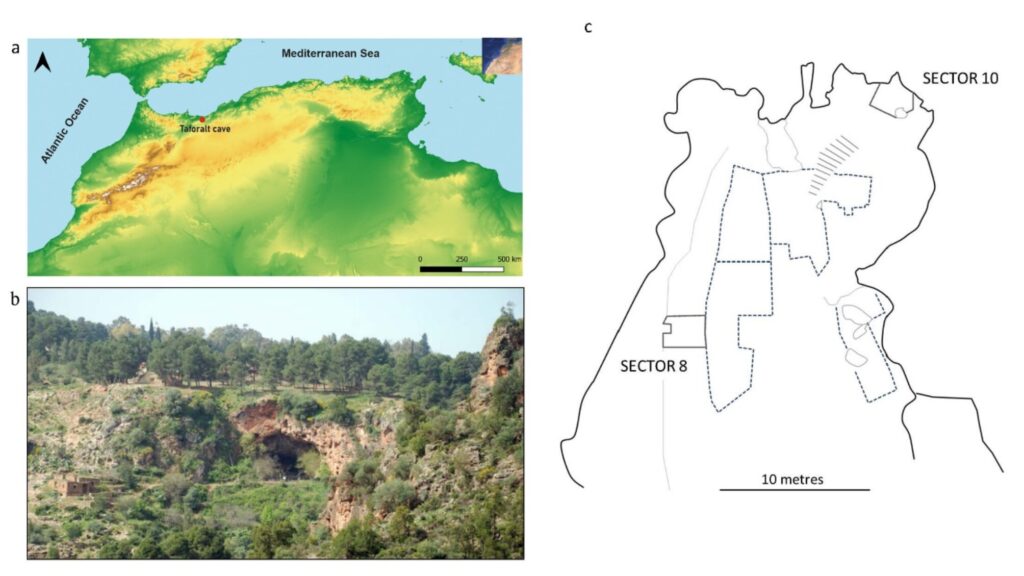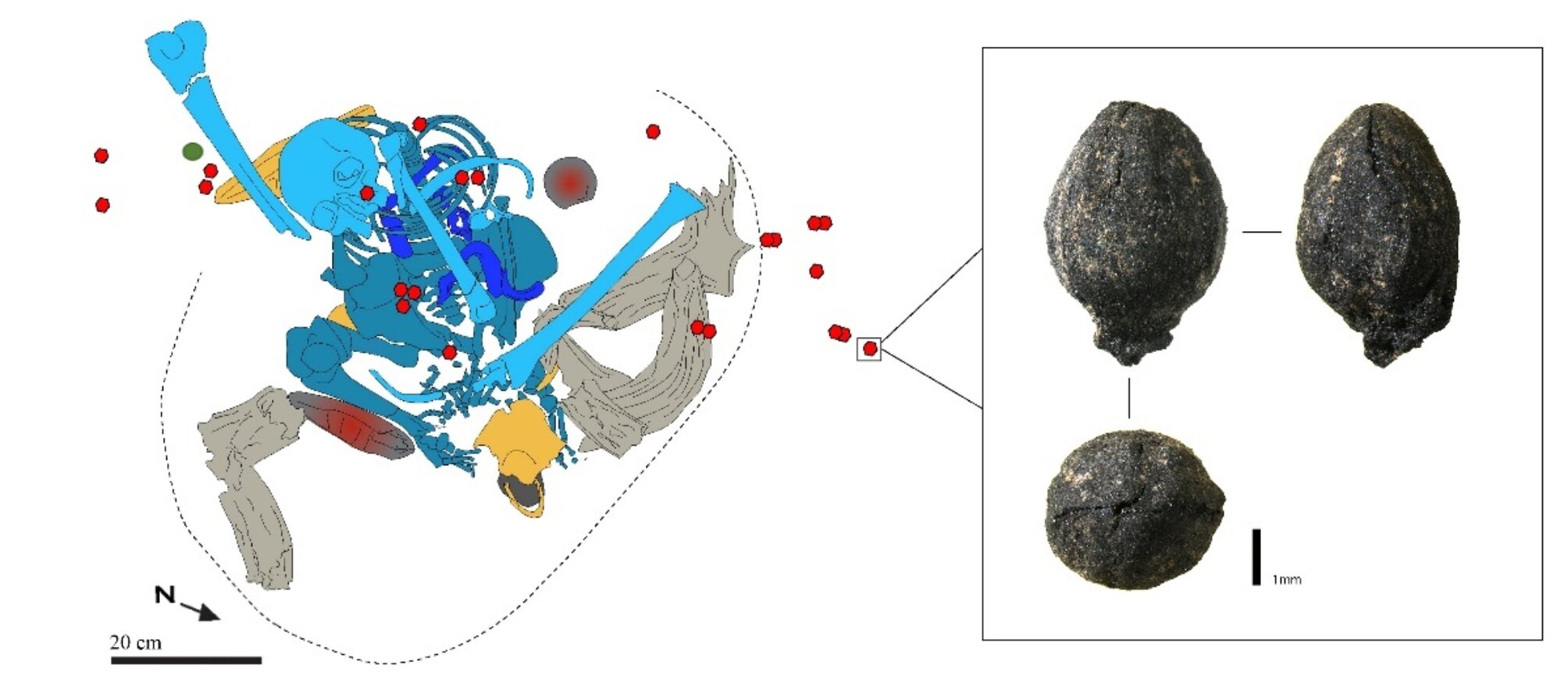In a groundbreaking discovery that sheds light on ancient human practices and plant usage, an international team of researchers, led by the University of Las Palmas de Gran Canaria, has uncovered the earliest evidence of Ephedra use in a 15,000-year-old human burial site located in northeastern Morocco. This fascinating revelation, stemming from the charred remains of Ephedra plants found within the burial pit, opens a window into the lives of the Iberomaurusian people who lived during the Late Pleistocene era.
Ephedra, a genus of shrubs typically found in arid regions, produces alkaloids such as ephedrine and pseudoephedrine. These chemical compounds have long been utilized in traditional medicine across many cultures, revered for their stimulating and medicinal properties. However, archaeological evidence of its use during the Paleolithic period has been exceedingly rare, largely due to the fragile nature of plant remains, which are prone to decay and difficult to preserve over millennia. This recent discovery, published in the journal Scientific Reports under the title “Late Pleistocene exploitation of Ephedra in a funerary context in Morocco,” provides a rare and invaluable insight into how ancient humans may have utilized this plant for ritualistic, medicinal, or dietary purposes.
The Excavation of Taforalt: A Gateway to the Past
The site of Taforalt, also known as Grotte des Pigeons (Cave of Pigeons), is a rich archaeological treasure trove. This cave, which was inhabited by modern humans for over 100,000 years, has long been a focal point for researchers investigating the lives of prehistoric populations. The Iberomaurusians, a group of Late Stone Age hunter-gatherers who lived between 23,000 and 12,600 years ago, are believed to have occupied Taforalt. Known for their microlithic bladelet industry and elaborate funerary practices, the Iberomaurusians left behind a wealth of cultural and archaeological evidence that continues to intrigue scientists.

Exceptional preservation conditions at Taforalt have allowed for the recovery of remarkably well-preserved organic materials, including carbonized plant remains found within the burial pit of an adult male. The cave’s dry environment, combined with its sheltered location, provided a unique setting for the preservation of delicate plant materials that might otherwise have been lost to the ravages of time. Among the findings were 23 charred cone bracts of Ephedra, a striking discovery that provides the earliest direct evidence of Ephedra use in prehistoric funerary contexts.
Ephedra: A Plant of Many Uses
Ephedra, a member of the Ephedraceae family, is native to a range of arid regions across the world. The plant is particularly well-known for its ability to thrive in harsh, dry environments, where few other plants can survive. Its fleshy cones contain alkaloids like ephedrine, which has stimulant properties, and pseudoephedrine, which is used in modern medicine to treat conditions like nasal congestion.
Throughout history, Ephedra has been utilized in a variety of ways. In traditional medicine, it has been employed to treat a range of ailments, from respiratory issues to fatigue, and it has been known for its energizing and therapeutic effects. In ancient cultures, particularly in Asia, it was often used in combination with other plants to create potent remedies. However, the adverse effects of regular Ephedra consumption, particularly on the central nervous and cardiovascular systems, have also been recognized, which is why it is likely that this plant was used sparingly and for specific purposes.
A Ritualistic Use of Ephedra: Insights from the Burial Site
The discovery of the Ephedra remains within the burial pit of a single individual suggests that the plant may have held significant ritualistic or symbolic importance in the funerary practices of the Iberomaurusians. Researchers suggest that the high concentration of Ephedra in the burial sediments, particularly in comparison to other areas of the cave, supports the theory that it was used in a specific context – likely related to the burial and mourning rites associated with the deceased.
The burial site itself is of great archaeological interest. It contains not only the charred remains of Ephedra but also unusual artifacts that speak to the cultural practices of the Iberomaurusians. Among these items are an ocher-coated mortar and pestle, as well as modified animal remains, suggesting that these people may have had an elaborate system of processing food, medicine, and perhaps even ceremonial offerings. The presence of such items, combined with the high concentration of Ephedra, hints at the idea that the plant was part of a ritualistic process, possibly serving as a means to honor the deceased or to assist in the spiritual transition of the individual.
Given the known effects of Ephedra’s alkaloids, which can affect the central nervous system and cardiovascular function, it is plausible that the plant was not consumed on a daily basis but reserved for special occasions or important cultural practices. The potential hallucinogenic or stimulant properties of Ephedra may have played a role in enhancing ceremonial rites, potentially serving to heighten emotional or sensory experiences during funerary ceremonies. The researchers speculate that Ephedra could have been used either to induce altered states of consciousness or to promote physical stamina, depending on the specific needs of the occasion.
Understanding the Iberomaurusians and Their Funeral Customs
The Iberomaurusians are known for their complex and sophisticated burial rituals, which included the careful placement of the dead in specific graves, often accompanied by grave goods and offerings. These funerary customs reflect a deep understanding of death and the afterlife, as well as a symbolic use of materials to ensure the well-being of the deceased in the next life. The inclusion of Ephedra in these rites indicates that the plant may have held a spiritual or medicinal significance, potentially aiding in the transition from life to death.
The funerary practices of the Iberomaurusians were part of a broader cultural tradition that spanned thousands of years in North Africa. Evidence from other burial sites suggests that these hunter-gatherers maintained a strong connection to the natural world, utilizing local resources not only for sustenance but also for spiritual and ritualistic purposes. The discovery of Ephedra in this context fits into a larger pattern of prehistoric peoples using plant materials, animals, and symbolic objects to navigate the complex terrain of death, belief, and ritual.
The Broader Implications of the Discovery
This remarkable discovery has far-reaching implications for our understanding of Paleolithic societies and their relationship with the environment. The use of Ephedra in a funerary context challenges previous assumptions about the role of plant-based substances in ancient rituals, particularly in regions where plant remains are scarce. It also suggests that ancient humans had a sophisticated knowledge of the medicinal and psychoactive properties of plants, using them with intention and care for specific purposes.
The findings from Taforalt also underscore the importance of preservation conditions in archaeological research. In this case, the dry, stable environment of the cave allowed for the remarkable preservation of plant material that would otherwise have decayed. This highlights the potential for future discoveries in other well-preserved archaeological sites, where similar plant-based evidence may reveal new insights into the ways in which ancient peoples interacted with their environment and utilized natural resources.
As researchers continue to study the site, further analysis may uncover more details about the use of Ephedra and other plants in the Iberomaurusian culture. The integration of plant remains with funerary practices offers a fascinating glimpse into the complex and multifaceted nature of prehistoric life, where the line between the physical and spiritual worlds was likely blurred.
Conclusion: A Window into the Past
The discovery of Ephedra remains in the ancient burial site at Taforalt not only adds a new chapter to the history of human use of plants but also enriches our understanding of the ritualistic and medicinal practices of the Iberomaurusians. This evidence suggests that ancient humans were far more attuned to the therapeutic and spiritual properties of the natural world than we might have previously thought.
By unveiling the significance of Ephedra in these funerary rites, the researchers have provided us with a deeper connection to the past, helping us to better understand how early human societies navigated life, death, and the natural environment. As studies continue to explore this and similar sites, we can expect even more revelations about the sophisticated cultural practices of prehistoric peoples, enriching our appreciation for the complexity of early human life. The ancient connection between humans and plants, as exemplified by this discovery, is a reminder that the wisdom of the past continues to shape our understanding of the world around us today.
Reference: Jacob Morales et al, Late pleistocene exploitation of Ephedra in a funerary context in Morocco, Scientific Reports (2024). DOI: 10.1038/s41598-024-77785-w
